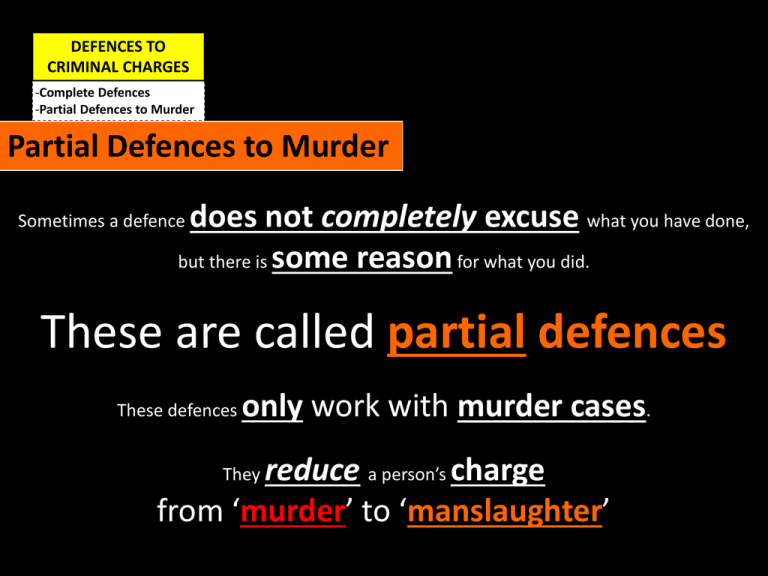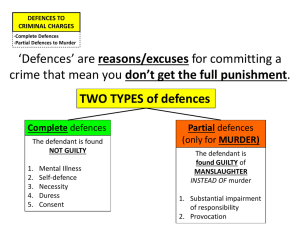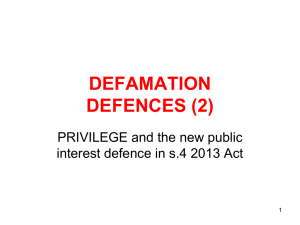
DEFENCES TO
CRIMINAL CHARGES
-Complete Defences
-Partial Defences to Murder
Partial Defences to Murder
does not completely excuse what you have done,
but there is some reason for what you did.
Sometimes a defence
These are called partial defences
These defences
only work with murder cases.
reduce a person’s charge
from ‘murder’ to ‘manslaughter’
They
DEFENCES TO
CRIMINAL CHARGES
-Complete Defences
-Partial Defences to Murder
Partial Defences to Murder
WHY DOES IT MATTER if you’re charged
with ‘Murder’ or ‘Manslaughter’?
Because the
penalties are VERY different…
DEFENCES TO
CRIMINAL CHARGES
-Complete Defences
-Partial Defences to Murder
Partial Defences to Murder
MURDER:
Average jail time: 18 years (13.5 non-parole)
Shortest sentence: 9 years
MANSLAUGHTER:
Average jail time: 7 years (4 non-parole)
Shortest sentence: 0 (10% didn’t get full time prison)
DEFENCES TO
CRIMINAL CHARGES
-Complete Defences
-Partial Defences to Murder
Partial Defences to Murder: Provocation
Would an “ordinary person”
also kill the victim?
DEFENCES TO
CRIMINAL CHARGES
-Complete Defences
-Partial Defences to Murder
Partial Defences to Murder: Provocation
e.g. R v Camplin (1978)
A 15 year-old boy’s uncle raped him and then laughed at the kid about
what had happened.
The boy hit his uncle on the head with a frying pan and killed him, even
though there was no threat (so it wasn’t in self-defence).
Would an ordinary person do the same thing? YES!
So it WAS seen as provocation (the victim provoked the boy to do it).
DEFENCES TO
CRIMINAL CHARGES
-Complete Defences
-Partial Defences to Murder
Partial Defences to Murder: Provocation
Assess the use of defences to criminal charges in achieving justice
CONTROVERSIAL CASES:
R v Singh (2012)
Mr Singh got 6 years for killing his wife after she told him
she wanted a divorce.
R v Won (2012)
Husband killed his wife’s lover after finding them in bed
together. He received 7½ years
DEFENCES TO
CRIMINAL CHARGES
-Complete Defences
-Partial Defences to Murder
Partial Defences to Murder: Provocation
Assess the use of defences to criminal charges in achieving justice
This caused politicians to ask whether we should still
have this defence if cases like this keep happening.
So NSW parliament created a Provocation Committee
to look at whether we should keep the defence.
DEFENCES TO
CRIMINAL CHARGES
-Complete Defences
-Partial Defences to Murder
Partial Defences to Murder: Provocation
Assess the use of defences to criminal charges in achieving justice
KEEP IT (it IS achieving justice) REMOVE IT (it is NOT achieving justice)
Women who are victims of domestic
Victoria already got rid of the defence in 2005, just
violence for many years sometimes “finally after the Ramage case (a guy only got 11 years for
crack” and kill their partner when he’s not killing his wife for insulting him).
abusing them at the time.
The defence has been used as a ‘gay panic defence’
by straight guys who kill gay men just because the
These women can’t use ‘self-defence’
guy hit on them (Green v The Queen). Women don’t
because there was no threat. They NEED
get to kill men who hit on them, so why should they
to use ‘provocation’.
be able to do this?
DEFENCES TO
CRIMINAL CHARGES
-Complete Defences
-Partial Defences to Murder
Partial Defences to Murder: Provocation
Assess the use of defences to criminal charges in achieving justice
The Provocation Committee recommended to parliament that we should:
KEEP it
(it IS achieving justice for women who were long term victims of
domestic violence)
but
CHANGE it
(so that men cannot argue that their wife offending their manhood
or a gay guy hitting on them counts as being provoked)
DEFENCES TO
CRIMINAL CHARGES
-Complete Defences
-Partial Defences to Murder
Partial Defences to Murder: Provocation
Assess the use of defences to criminal charges in achieving justice
They said we should change it to
Gross
Provocation
DEFENCES TO
CRIMINAL CHARGES
-Complete Defences
-Partial Defences to Murder
Partial Defences to Murder: Provocation
Assess the use of defences to criminal charges in achieving justice
The Premier backed the changes and
said the law would be changed by the
end of 2013.
DEFENCES TO
CRIMINAL CHARGES
-Complete Defences
-Partial Defences to Murder
Partial Defences to Murder:
Substantial impairment of responsibility
SUBSTANTIAL = serious
IMPAIRMENT = thing that holds you back
OF = from (?)
RESPONSIBILITY = being completely responsible for what you did
DEFENCES TO
CRIMINAL CHARGES
-Complete Defences
-Partial Defences to Murder
Partial Defences to Murder:
Substantial impairment of responsibility
This is kind of like insanity, but with insanity you have to have a mental
illness ALL the time that stops you from EVER understanding that what
you were doing was wrong.
With substantial impairment of responsibility, you just have to have an
abnormality of the mind that caused them to carry out the crime, but
they are otherwise not insane!
ABNORMALITY = SOMETHING DIFFERENT/WRONG
OF THE MIND = OF THAT WARM THING BETWEEN YOUR EARS
DEFENCES TO
CRIMINAL CHARGES
-Complete Defences
-Partial Defences to Murder
Partial Defences to Murder:
Substantial impairment of responsibility
This defence is more common than mental illness because it is MUCH EASIER to prove since the
person can be normal in every other way
Byrne v R (1960) - The defendant had no control over his violent sexual fantasies. Other than
this the guy was pretty normal.
He strangled a young woman to death while he was delusional.
The court accepted that the guy had an abnormality of mind which substantially impaired his
capacity to take responsibility for his actions.
Because he wasn’t crazy when he wasn’t around women and wasn’t having these fantasies, he
couldn’t use the mental illness/insanity defence.
He was found guilty of manslaughter instead of murder.










